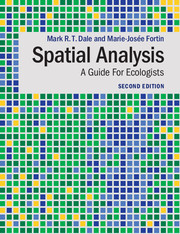Book contents
- Frontmatter
- Dedication
- Contents
- Preface
- 1 Spatial concepts and notions
- 2 Ecological and spatial processes
- 3 Points, lines and graphs
- 4 Spatial analysis of complete point location data
- 5 Contiguous units analysis
- 6 Spatial analysis of sample data
- 7 Spatial relationship and multiscale analysis
- 8 Spatial autocorrelation and inferential tests
- 9 Spatial partitioning: spatial clusters and boundary detection
- 10 Spatial diversity analysis
- 11 Spatio-temporal analysis
- 12 Closing comments and future directions
- References
- Index
Preface
Published online by Cambridge University Press: 05 September 2014
- Frontmatter
- Dedication
- Contents
- Preface
- 1 Spatial concepts and notions
- 2 Ecological and spatial processes
- 3 Points, lines and graphs
- 4 Spatial analysis of complete point location data
- 5 Contiguous units analysis
- 6 Spatial analysis of sample data
- 7 Spatial relationship and multiscale analysis
- 8 Spatial autocorrelation and inferential tests
- 9 Spatial partitioning: spatial clusters and boundary detection
- 10 Spatial diversity analysis
- 11 Spatio-temporal analysis
- 12 Closing comments and future directions
- References
- Index
Summary
Spatial analysis has been a rapidly growing field in ecology for the past decade (e.g. since Fortin & Dale 2005). This growth derives from at least three factors: (1) an awareness among ecologists that spatial structure is an essential component in ecological thinking; (2) the all-too-obvious alteration of landscapes around us at an increasing rate, requiring constant re-evaluation of their spatial heterogeneity; and (3) the ready availability of software to perform many types of spatial analyses. One major problem with the broad availability of spatial analysis software is that it is easy to use them incorrectly. Incorrect application arises because: (1) ecologists are not fully aware of the issues of spatial scales; (2) ecologists are only slowly realizing the full implications of the prevalence of spatial autocorrelation in their data, which are usually not independent and thus violate the assumptions of standard statistics; and (3) ecologists are aware of the importance of spatial structure in the systems they study, but they are not yet familiar with the many different ways that spatial structure can occur in those systems. In part, that is why we need to go beyond narrowly defined spatial statistics into the broader area of spatial analysis more generally. The purpose of this book is therefore to provide a bridge between the current understanding of the need for spatial analysis and the uncertainty of many ecologists on how to perform and interpret these kinds of analysis.
Information
- Type
- Chapter
- Information
- Spatial AnalysisA Guide For Ecologists, pp. xi - xivPublisher: Cambridge University PressPrint publication year: 2014
Accessibility standard: Unknown
Why this information is here
This section outlines the accessibility features of this content - including support for screen readers, full keyboard navigation and high-contrast display options. This may not be relevant for you.Accessibility Information
- 1
- Cited by
